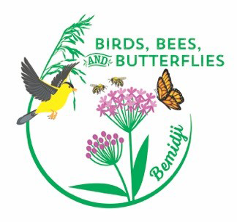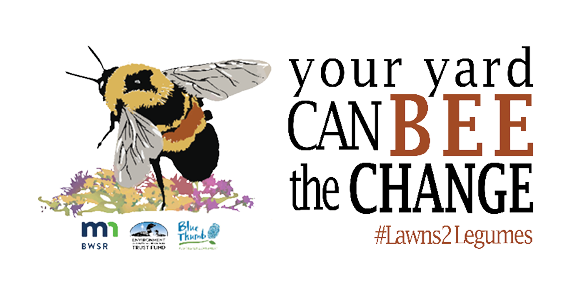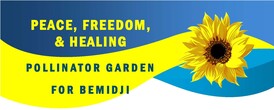|
Localized Information: BBBB Partners created a brochure about native species to plant in the Bemidji area to benefit birds and pollinators. It is available at local garden centers. A more comprehensive list of native wildflowers, trees, and shrubs; and other helpful information can be found by clicking the "Get Started with Native Plants" button above.
Take a Self-guided tour of Bemidji Native Plant Gardens from home, or download the map, click on the QR code and get detailed information and pictures as you visit each site. |
Birds, Bees & Butterflies - BemidjiBirds, bees, and butterflies have several things in common – they all depend on native plants; they play an important role in pollination; and all face increasing pressures from loss of habitat, diseases, and non-native invasive competitors. But there are things we can do to help! One of the most important is to add native plants to our gardens and landscapes.
Birds, Bees & Butterflies Bemidji PartnersThe Mississippi Headwaters Audubon Society, Bemidji Monarch Project committee and several other local organizations and businesses have joined together in a campaign called "Birds, Bees & Butterflies - Bemidji" to promote the planting of native trees, shrubs, and wildflowers in our community to benefit birds and pollinators. By planting a native plant garden, or just adding native species to your existing landscape, you can attract colorful birds and pollinators to your yard or business.
|
BWSR accepting applications for fall 2024 Lawns to Legumes projects
|
The Minnesota Board of Water and Soil Resources (BWSR) is accepting applications for fall 2024 Lawns to Legumes pollinator habitat projects. The Lawns to Legumes program aims to increase habitat for at-risk pollinators in residential settings across the state by providing people with cost-share funding, workshops, coaching and gardening resources. Anyone who lives in Minnesota and has a yard, deck, or other outdoor space for planting can apply to be reimbursed for up to $400 in costs associated with establishing new pollinator habitat in their yards. The program is available to both homeowners and renters.
|
Applications will be accepted through May 15, 2024. If you previously applied for the program, you will need to reapply to be considered for fall 2024 funding.
More than 4,000 residential habitat projects across all 87 Minnesota counties have been implemented since the program launched in 2019. The program shares online resources such as gardening templates, habitat guides and advice about selecting native plants for all Minnesotans interested in creating pollinator habitat in their yards. Lawns to Legumes receives funding from the Environment and Natural Resources Trust Fund and the state General Fund. Apply online at Blue Thumb’s website. For more information about Lawns to Legumes, visit BWSR’s website.
More than 4,000 residential habitat projects across all 87 Minnesota counties have been implemented since the program launched in 2019. The program shares online resources such as gardening templates, habitat guides and advice about selecting native plants for all Minnesotans interested in creating pollinator habitat in their yards. Lawns to Legumes receives funding from the Environment and Natural Resources Trust Fund and the state General Fund. Apply online at Blue Thumb’s website. For more information about Lawns to Legumes, visit BWSR’s website.
bbbb activities
Since 2017, Birds, Bees & Butterflies - Bemidji has:
- Collaborated on over a dozen pollinator plantings (City Hall, Watermark Art Center, Bemidji Library, Beltrami County History Center, North Country Park, Lincoln School, Middle School, Cass Lake-Bena School, Leech Lake Tribal College, Bemidji State University campus, and others)
- Conducted a half dozen workshops for residents & businesses on how to incorporate native plants into their yards and landscapes
- Developed information brochures & flyers, and interpretive signage at plantings
- Held several informational events & celebrations, including an annual Monarch Butterfly Festival
- Designed and put up the “Celebrate Bemidji Wildflowers” light post banners around town
- Posted a virtual native plant garden so visitors can drive by and see these planting and hopefully inspire them to try one
- Worked with the City of Bemidji to initiate No Mow May
Current projects
|
Top 10 Native Plants
Each year, Birds, Bees & Butterflies - Bemidji highlights 10 native plants which attract birds and pollinators to your yard. In 2023 we are focusing on drought resistant native wildflowers, grasses, trees, and shrubs Click here, or on the image of the flyer to get a copy of this year's Top 10 list. Check out our Top 10 Native Plants from 2018 , 2019 , 2020, 2021, 2023, and 2024. |
|
No Mow May
May is when pollinator species return from migration or come out of hibernation and need locally-sourced nectar. Even small changes to minimize impacts on bees can make a big difference. By signing up, participants agree to not mow their yards for the month of May. The city's goal is to "provide early season forage for emerging native pollinators by reducing lawn mowing frequency during a month where foraging resources are limited" Register for No Mow May here |
|
Help us plant a 'Peace, Freedom, & Healing' Pollinator Garden in Bemidji. Click below to learn more about this project
|

Note on Ojibwe plant names:
Birds, Bees & Butterflies - Bemidji includes Ojibwe language names along with the common and/or scientific names of plant species in some of our materials. Bemidji is at the center of Minnesota's three largest Indian tribes: Red Lake Nation, White Earth Nation, and Leech Lake Band of Ojibwe. More than 200 business, schools, and offices in the Bemidji area post bilingual signage in English and Ojibwe as part of the 'Ojibwe Language Project'. A good resource to consult for Ojibwe plant names and uses is "Plants Used by the Great Lakes Ojibwa", Great Lakes Indian Fish & Wildlife Council. The Leech Lake Band has a Field Guide and Journal with local Ojibwe names of plants and animals. We have also been assisted by Dr. Anton Treuer, Professor of Ojibwe Language at Bemidji State University with selecting appropriate Ojibwe plant names. |
|





















